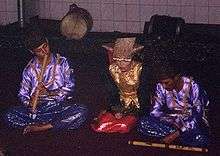Saluang
- for the tambon in Thailand see Saluang, Thailand

The saluang is a traditional musical instrument of the Minangkabau people of West Sumatra, Indonesia. It is similar to the flute in general and made of bamboo. It is related to the suling of other parts of Indonesia.
It is made of thin bamboo or "talang" (Schizostachyum brachycladum Kurz),[1] with 4 hole. Saluang more simple than other kind of flute because it is made just adding 4 holes and finish. The dimension of saluang is 3–4 cm in diameter and 40–60 cm in length. It is related to the suling of other parts of Indonesia.
Saluang player can play that music instrument without interrupting for taking breath from start to end of song. They have developed special breath technique in blowing that instrument without stopping for breathtaking.
Minangkabau people believe that talang which is collected from rack of clothes dryer or found drifting in the river is a good material for making saluang.[2] Traditionally Minangkabau people also use talang as a container for sticky rice food (lamang, lemang) and as horizontal rack for drying clothes (jemuran kain) under sunlight .
One famous saluang player is Idris Sutan Sati with saluang female singer Syamsimar. Today, it is not so easy to find classic saluang cassette even in original place of saluang (Minangkabau).
Style of saluang tune for example : Singgalang, Pariaman, Koto Tuo, Ratok Solok, Cupak, Salayo and Pauah. Singgalang style is quite difficult for the beginners. High skilled saluang player can play many styles and audience can request any style to them.
In the past, Minangkabau people believed that saluang player have pitunang (mantra) or magic power for hypnotizing the audience. That mantra called as Pitunang Nabi Daud [3]
References
- ↑ http://www.plantamor.com/spcdtail.php?recid=1624
- ↑ Interview with A Dt Batuah, penghulu suku Caniago Koto Laweh, Solok, Sumatera Barat, 1993
- ↑ Interview with Magatin Budua, traditional artis Minangkabau from Muaro Bodi, Sawahlunto, Sumatera Barat,1993